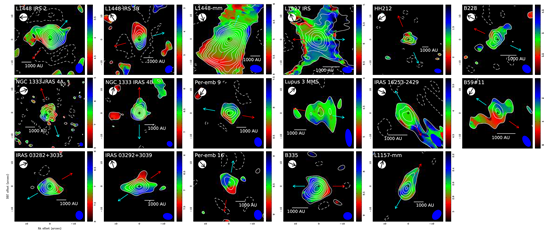|
圖片來源: Hsi-Wei Yen, Patrick Koch, Shigehisa Takakuwa, Paul Ho, Nagayoshi Ohashi, and Ya-Wen Tang

SMA images of the C18O (2-1) emission in the 17 Class 0 and 0/I protostellar sources. Contours show the intensity distribution of the C18O (2-1) emission, tracing the distribution of the gas around the protostars. Color scales show the mean velocity of the C18O (2-1)
emission, tracing the motions of the ambient gas. Blue and red arrows denote the directions of the outflowing gas associated with these protostar, which can represent the rotational axes of these systems. Black arrows on the tops of filled white circle show the directions
that how the mean velocities change with the positions. If the directions of the trends in the changes of the motional velocities are more perpendicular to the rotational axes, the sources likely exhibit faster rotational motions dominant over infalling velocities, and hence larger circumstellar disks.
|
| We perform imaging and analyses of the SMA data of the C18O (2-1) emission in 17 Class 0 and Class 0/I protostellar sources to study their gas kinematics on a 1000-AU scale. The SMA data show that these sources exhibit diverse gas motions. The infalling and rotational of the ambient gas around the protostars can differ by more than one order of magnitude, even though they are at the similar evolution stage. Based on these motional velocities, the sizes of the circumstellar disks surrounding these protostars are inferred to be from less than 5 AU to more than 100 AU. The wide ranges of the motional velocities and the inferred disk sizes can suggest that the gas kinematics in Class 0 sources evolves quickly as more material collapses toward the vicinity of the protostars, and the circumstellar disks can grow fast. These disks around the young protostars will further evolve to be the disks like those observed around T Tauri stars, the future sites of planet formation. (Yen et al. 2015, ApJ, 799, 193) |
 asiaa.sinica.edu.tw 媒體連絡: epo
asiaa.sinica.edu.tw 媒體連絡: epo asiaa.sinica.edu.tw
asiaa.sinica.edu.tw